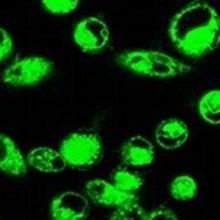membrane

Mutations in Autism-Linked Gene Cause Membrane Mischief
Holly Barker, PhD, Spectrum | Jan 26, 2023 | 4 min read
Inactivating TAOK1 prompts tentacle-like protrusions to form all over a neuron’s surface, revealing the gene’s role in molding the membrane.

How Intracellular Bacteria Hijack Your Cells
Catherine Offord | Dec 1, 2022 | 10+ min read
Scientists studying pathogens such as Chlamydia, Legionella, and Listeria get a master class in how to control the internal workings of mammalian cells.

Infographic: Intracellular Bacteria’s Tricks for Host Manipulation
Catherine Offord | Dec 1, 2022 | 2 min read
Various microbes, including several human pathogens, hijack the cell’s skeleton, membranes, and protein-making machinery to make themselves at home.

How to Win at Westerns
The Scientist | Oct 2, 2020 | 1 min read
Download this ebook to learn the ins and outs of Western blotting!

Cracking Down on Cancer: A Profile of Owen Witte
Diana Kwon | Apr 1, 2020 | 9 min read
Through his studies on cancer-causing viruses, the University of California, Los Angeles, professor has helped develop lifesaving treatments.

Image of the Day: Unusual ATP Synthase
Emily Makowski | Jan 8, 2020 | 2 min read
A single-celled organism has an energy-producing enzyme with unique features.

New Technologies Shed Light on Caveolae
Ben Nichols | Jun 1, 2018 | 10+ min read
The functions of the cellular invaginations identified more than half a century ago are now beginning to be understood in detail.

Infographic: Caveolae Form and Function
Ben Nichols | May 31, 2018 | 1 min read
Researchers interrogate the cavernous structures on the surface of cells to better understand how they affect membrane function.

Molecules that Could Form “Membranes” Found Above Titan
Jef Akst | Jul 31, 2017 | 2 min read
Vinyl cyanide is thought to rain down onto Saturn’s largest moon, though whether the molecule self-assembles into membrane-like structures is unclear.

Opinion: Life’s X Factor
Nick Lane | Aug 4, 2015 | 4 min read
Did endosymbiosis—and the innovations in membrane bioenergetics it engendered—make it possible for eukaryotic life to evolve?

Next Generation: Synthetic Phospholipids Track Cancer
Ruth Williams | Jun 11, 2014 | 3 min read
Scientists generate tumor-targeting molecules that can be used for imaging and treatment.

Palade Particles, 1955
Kerry Grens | Feb 1, 2014 | 2 min read
Electron microscopy led to the first identification of what would later be known as ribosomes.

Palade and His Particles
Kerry Grens | Jan 31, 2014 | 1 min read
Nobel Laureate Christian de Duve discusses the impact of George Palade’s work on ribosomes.

New Organelle: The Tannosome
Kerry Grens | Sep 23, 2013 | 1 min read
Researchers identify a structure in plants responsible for the production of tannins.

How Autophagy Works
Muriel Mari, Sharon A. Tooze, and Fulvio Reggiori | Feb 1, 2012 | 1 min read
There are five steps of autophagosome biogenesis: induction, expansion, vesicle completion, fusion, and cargo degradation.
The Enigmatic Membrane
Muriel Mari, Sharon A. Tooze, and Fulvio Reggiori | Feb 1, 2012 | 10+ min read
Despite years of research, the longstanding mystery of where the autophagosome gets its double lipid bilayers is not much clearer.
